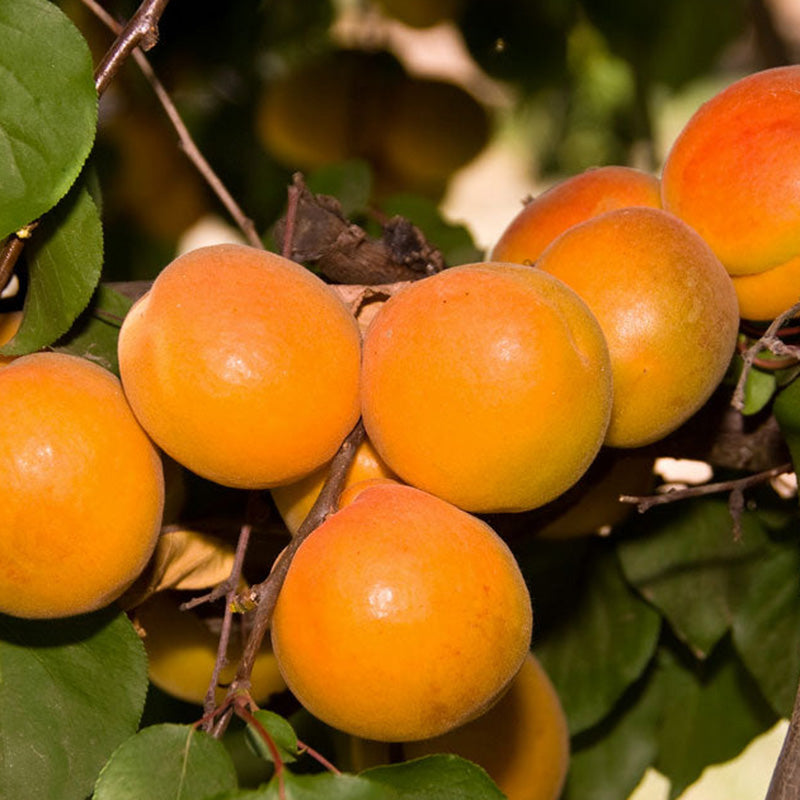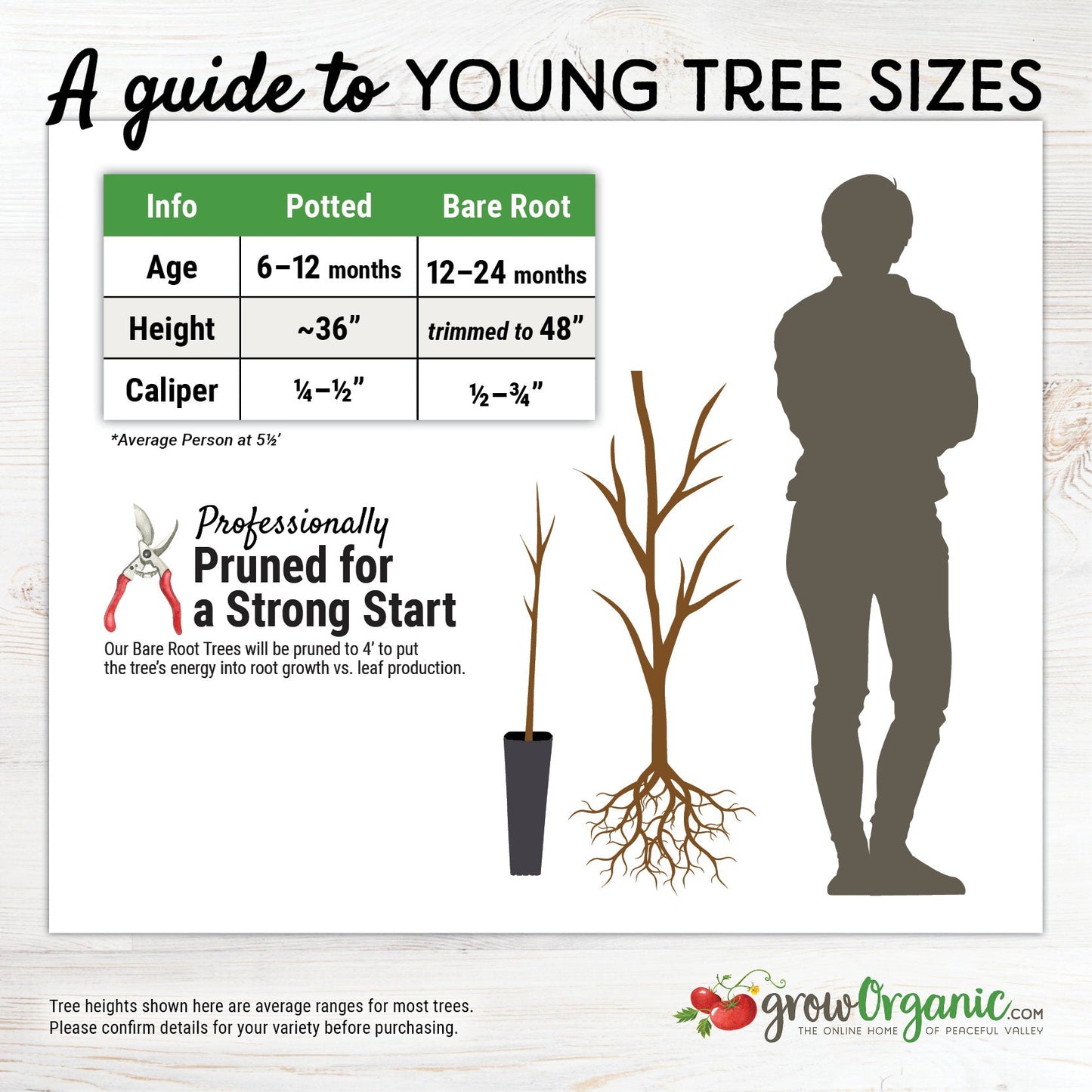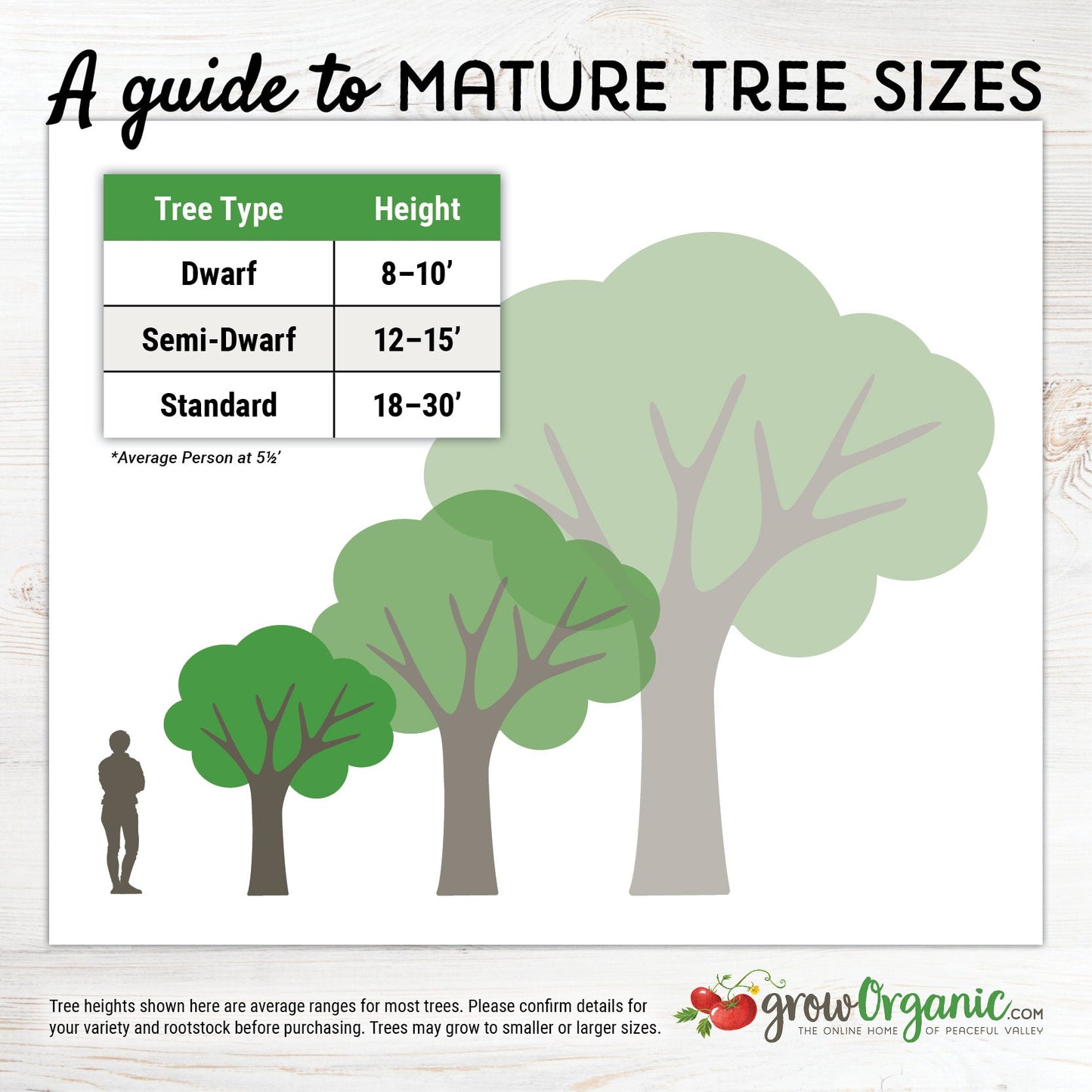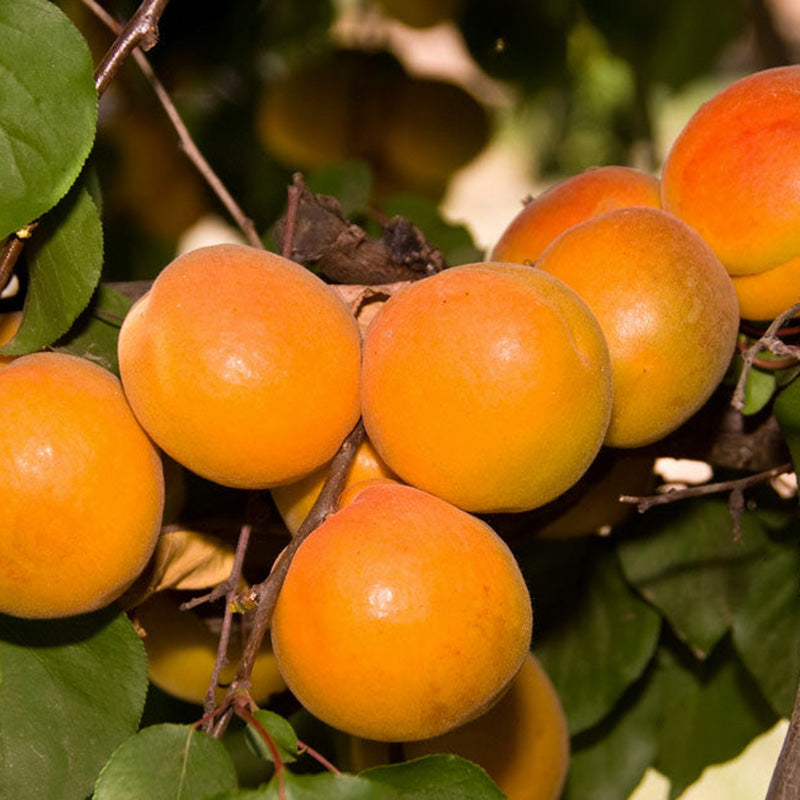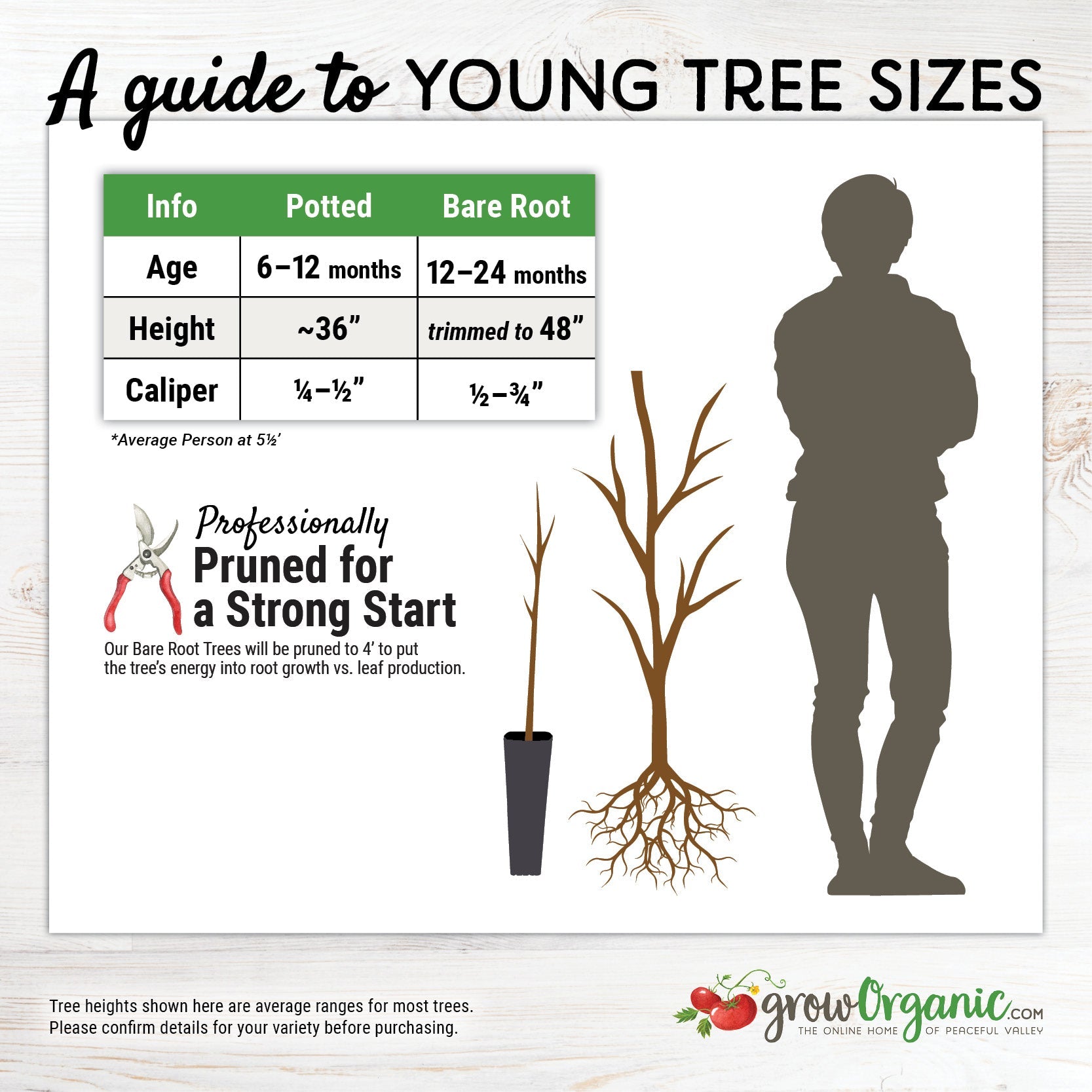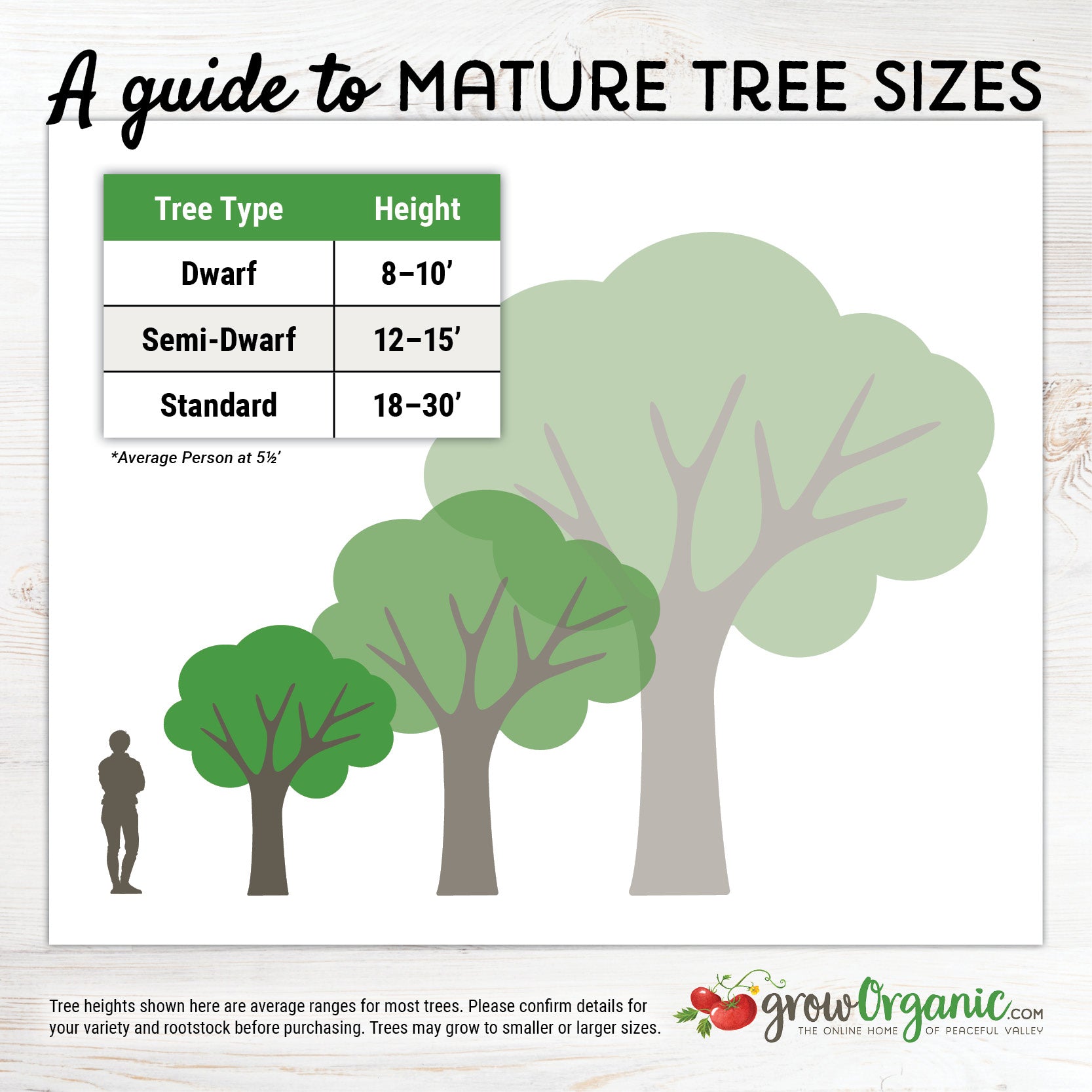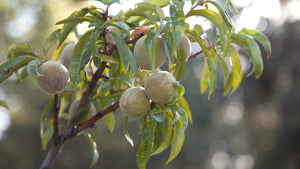Item Number: FT071
Harcot Apricot Tree
Harcot Apricot Tree
Frost Hardy and Disease Resistant
Semi-dwarf on Citation rootstock.
- Zones: 5-9
- Chill hours: 700-900
- Bloom Time: Late (Based on typical Central Valley California weather)
- Harvest: June 5 - June 15
- Looks: Medium to large fruit often blushed with red.
- Personality: Sweet, juicy, rich flavor one of the best.
- Facts of note: Harcot is considered to be one of the finest tasting apricots today. Harcot is a tremendously hardy selection introduced by the Harrow Research Station in Canada. The range of adaptability of this variety is one of its primary appeals, doing well in zones 5 through 9. Once established you can expect consistent production even in areas considered marginal for Apricots. A good choice for colder climates where a late frost could devastate other apricots varieties. This is a beautiful, large, yellow-orange fruit with a very sweet, very rich traditional apricot flavor. Large yellow fruit that has juice running down your are when fully ripe. The tree is a robust deep green with a rounded canopy . The Spring flush of foliage is a beautiful red that adds to the ornamental appeal. Harcot apricot is good for canning, cooking, or freezing and of course fresh eating.
- Pollination: Self-fruitful.
Harcot Apricot Tree: A Delectable Addition to Your Orchard
Apricot enthusiasts and orchard owners alike will appreciate the Harcot Apricot tree for its exceptional fruit quality, striking appearance, and unique characteristics. This semi-dwarf apricot tree is a valuable addition to any garden or orchard, offering not only delicious apricots but also an ornamental presence.
Taste Sensation: A Flavorful Delight
The Harcot Apricot is renowned for its outstanding flavor, making it a sought-after choice among fruit connoisseurs. The fruit boasts a delightful combination of sweetness and tanginess, striking a perfect balance that titillates the taste buds. Its juicy, tender flesh offers a burst of fruity goodness with each bite, making it a favorite for fresh eating, preserves, jams, and baking.
One of the key highlights of the Harcot Apricot's taste is its low acidity, which distinguishes it from many other apricot varieties. This low acidity contributes to its smooth and mild flavor profile, making it an ideal choice for those who prefer a less tart apricot experience. The apricots are typically medium to large in size, with a vibrant orange hue that adds to their visual appeal.
Aesthetic Charm: Beauty in Your Orchard
The Harcot Apricot tree is not just a bearer of delicious fruit but also an ornamental gem for your orchard. This semi-dwarf tree displays a graceful and compact growth habit, reaching a height of approximately 10 to 12 feet at maturity. Its attractive canopy features dense, dark green foliage that provides a stunning backdrop for the apricots.
During the spring, the Harcot Apricot tree bursts into a dazzling display of fragrant pink and white blossoms. These delicate flowers not only add to the tree's visual charm but also attract pollinators, ensuring a bountiful harvest. As the season progresses, the tree's foliage remains lush and vibrant, creating an appealing contrast against the bright apricot fruits.
Distinguishing Characteristics: What Sets Harcot Apart
While there are numerous apricot varieties available, the Harcot Apricot stands out for several reasons:
Low Chill Requirement: Harcot Apricots have a relatively low chill requirement, which means they can thrive in regions with mild winters. This adaptability allows a broader range of gardeners to enjoy their delectable fruit.
Self-Fertile: The Harcot Apricot tree is self-fertile, which means it does not require a pollinator tree to set fruit. This convenience makes it an excellent choice for smaller gardens or orchards where space may be limited.
Disease Resistance: This apricot variety demonstrates good resistance to common apricot diseases, including brown rot and bacterial canker. This resilience makes it easier to maintain and less prone to disease-related issues.
Consistent Fruit Production: Harcot Apricots are known for their reliable and consistent fruit production. You can expect a plentiful harvest year after year, provided the tree is well-cared for.
The Harcot Apricot tree is a valuable addition to any orchard or garden, offering a delectable fruit with a balanced flavor profile, an attractive appearance, and unique characteristics that set it apart from other apricot varieties. Whether you are a seasoned orchardist or a novice gardener, the Harcot Apricot tree is sure to delight your senses and provide you with years of fruit-bearing enjoyment.
Visit our Fruit Tree Central for a listing of all our fruit tree videos and articles.
Visit Tree Characteristics for a listing of all our fruit & nut tree growing characteristics.


Check Your Zone Compatibility:
Compatible with your zone.
Growing Zone for
,

Our Guarantee To You
Since 1976, we've served our customers at every stage of growing. Please contact us at any time. We are happy to support and assist you.
Description
Description
Semi-dwarf on Citation rootstock.
- Zones: 5-9
- Chill hours: 700-900
- Bloom Time: Late (Based on typical Central Valley California weather)
- Harvest: June 5 - June 15
- Looks: Medium to large fruit often blushed with red.
- Personality: Sweet, juicy, rich flavor one of the best.
- Facts of note: Harcot is considered to be one of the finest tasting apricots today. Harcot is a tremendously hardy selection introduced by the Harrow Research Station in Canada. The range of adaptability of this variety is one of its primary appeals, doing well in zones 5 through 9. Once established you can expect consistent production even in areas considered marginal for Apricots. A good choice for colder climates where a late frost could devastate other apricots varieties. This is a beautiful, large, yellow-orange fruit with a very sweet, very rich traditional apricot flavor. Large yellow fruit that has juice running down your are when fully ripe. The tree is a robust deep green with a rounded canopy . The Spring flush of foliage is a beautiful red that adds to the ornamental appeal. Harcot apricot is good for canning, cooking, or freezing and of course fresh eating.
- Pollination: Self-fruitful.
Harcot Apricot Tree: A Delectable Addition to Your Orchard
Apricot enthusiasts and orchard owners alike will appreciate the Harcot Apricot tree for its exceptional fruit quality, striking appearance, and unique characteristics. This semi-dwarf apricot tree is a valuable addition to any garden or orchard, offering not only delicious apricots but also an ornamental presence.
Taste Sensation: A Flavorful Delight
The Harcot Apricot is renowned for its outstanding flavor, making it a sought-after choice among fruit connoisseurs. The fruit boasts a delightful combination of sweetness and tanginess, striking a perfect balance that titillates the taste buds. Its juicy, tender flesh offers a burst of fruity goodness with each bite, making it a favorite for fresh eating, preserves, jams, and baking.
One of the key highlights of the Harcot Apricot's taste is its low acidity, which distinguishes it from many other apricot varieties. This low acidity contributes to its smooth and mild flavor profile, making it an ideal choice for those who prefer a less tart apricot experience. The apricots are typically medium to large in size, with a vibrant orange hue that adds to their visual appeal.
Aesthetic Charm: Beauty in Your Orchard
The Harcot Apricot tree is not just a bearer of delicious fruit but also an ornamental gem for your orchard. This semi-dwarf tree displays a graceful and compact growth habit, reaching a height of approximately 10 to 12 feet at maturity. Its attractive canopy features dense, dark green foliage that provides a stunning backdrop for the apricots.
During the spring, the Harcot Apricot tree bursts into a dazzling display of fragrant pink and white blossoms. These delicate flowers not only add to the tree's visual charm but also attract pollinators, ensuring a bountiful harvest. As the season progresses, the tree's foliage remains lush and vibrant, creating an appealing contrast against the bright apricot fruits.
Distinguishing Characteristics: What Sets Harcot Apart
While there are numerous apricot varieties available, the Harcot Apricot stands out for several reasons:
Low Chill Requirement: Harcot Apricots have a relatively low chill requirement, which means they can thrive in regions with mild winters. This adaptability allows a broader range of gardeners to enjoy their delectable fruit.
Self-Fertile: The Harcot Apricot tree is self-fertile, which means it does not require a pollinator tree to set fruit. This convenience makes it an excellent choice for smaller gardens or orchards where space may be limited.
Disease Resistance: This apricot variety demonstrates good resistance to common apricot diseases, including brown rot and bacterial canker. This resilience makes it easier to maintain and less prone to disease-related issues.
Consistent Fruit Production: Harcot Apricots are known for their reliable and consistent fruit production. You can expect a plentiful harvest year after year, provided the tree is well-cared for.
The Harcot Apricot tree is a valuable addition to any orchard or garden, offering a delectable fruit with a balanced flavor profile, an attractive appearance, and unique characteristics that set it apart from other apricot varieties. Whether you are a seasoned orchardist or a novice gardener, the Harcot Apricot tree is sure to delight your senses and provide you with years of fruit-bearing enjoyment.
Visit our Fruit Tree Central for a listing of all our fruit tree videos and articles.
Visit Tree Characteristics for a listing of all our fruit & nut tree growing characteristics.
About Apricots: Blooms very early; generally difficult to grow, especially in late frost areas. Needs well-drained, moderately fertile soil. Thin fruit early in season to maximize size and quality. Susceptible to bacterial canker, shot hole fungus, brown rot and peach twig borer. Browse all our apricot trees for sale.
Please Note: Although most of our bare-root trees arrive to our warehouse in mid-December, there are a few varieties that will not arrive until mid-January. If you order any of those varieties along with varieties that arrive in mid-December, your order will be delayed for shipment until mid-January. If you'd like us to split your shipments, please contact us at (888) 784-1722 or orderdesk@groworganic.com. Additional shipping charges will apply.
Shipping Information
Shipping Information
Cannot ship to the following states: HI, AK, PR, GU, VI
Cannot ship via USPS.
Cannot ship via SmartPost.
Shipping Weight: 5.0 lb
Dimensions: 55.5"L x 7.3"W x 2.75"H
Features
Features
- Freestone
- Self-fruitful
- Suited to Cold Climates
Characteristics
Characteristics
Planting & Care
Planting & Care
Useful Information
Useful Information
Guarantee
Guarantee
Limited Dormant Tree & Plant Guarantee
* Claim deadline is June 15th
We guarantee that your dormant tree or plant will arrive in good, viable condition. If your tree arrives in substandard condition, notify us within 3 days of delivery. Please email pictures of the box, inside packaging, the tree and its roots to helpdesk@groworganic.com. We will investigate your claim and process a request to exchange or refund the damaged product.
If your dormant tree or plant has not grown new leaves by June 15th, you may be eligible for our Limited Dormant Tree & Plant Guarantee. This guarantee provides for a store credit for the purchase price of the tree, excluding shipping. Please see the Instructions below.
Important Dates:
- April 1st Dormant trees/plants must be planted in the ground
- May 15th Perform scratch test, if no new leaves have grown
- June 15th Deadline to apply for a dormant tree/plant credit
All required documentation must be received by June 15th for your claim to be considered. Claims or documentation received after June 15th will be denied, without exception. Instructions listed below
Terms and Conditions
We cannot guarantee that your tree or plant will remain alive and healthy after it is received, or bear fruit as there are too many variables in your environment that are beyond our control (i.e. soil preparation, weed and pest control, proper irrigation, chill hours, compatible hardiness for your growing zone, proper choice of pollinator, extreme weather, rodent damage, disease, etc.).
We cannot guarantee that we will be able to provide a replacement tree/plant of the same species either that same growing season or in future years. Customers are responsible for all shipping fees associated with replacement trees and plants.
If we determine that the tree you purchased directly from us is not viable, we will issue you a store credit (not a refund) for the purchase price of the affected dormant tree or plant. Shipping is not included in the dormant tree/plant guarantee. Store credits can be used to purchase any product we sell and are valid for use only until July 1st of the following year.
Historically, 98% of our dormant trees and plants grow and thrive when they have been cared for and planted using our growing guides. Dormant trees and plants must be planted in the ground by April 1st in order to be eligible for credit. If the ground in your area is still frozen solid, you may temporarily plant your tree or plant in a pot.
Potted, non-dormant trees or plants are excluded from this guarantee as they are not dormant at the time of shipment. Evergreen trees such as citrus, avocado and olive trees are not available for credit under the Dormant Tree and Plant Guarantee.
Instructions
We guarantee that your dormant fruit tree or plant will leaf out, if you care for it according to our growing guides. In the unlikely event that your dormant tree or plant does not have leaves by May 15th, follow these simple steps to apply for a store credit:
Before you call or email, please perform a “scratch test” to determine if the tree or plant is still alive. This video shows how to check for live tissue under the bark. Scratch tests need to be done a few inches above and below the graft.
Green Cambium Layer / Living Trees
If the cambium layer under the bark is green, give your tree a little more time. It is still alive, but hasn’t come out of dormancy yet. Check to make sure that it is getting the right amount of deep root water, enough sunlight and that the weather is warm enough for that type of tree/plant to come out of dormancy. Every tree has its own personality and will come out of dormancy at different times. Be sure to submit the required documentation listed below by June 15th, if it doesn’t grow leaves.
Brown Cambium Layer / Dead Trees
If the scratch test shows a brown cambium layer or if your dormant tree/plant doesn’t have leaves by June 1st, please email us at helpdesk@groworganic.com. All required documentation listed below must be received by June 15th for your claim to be considered. To be considered for the guarantee claim, all required documentation must be received by June 15th. Incomplete submissions will be denied.
Required Documentation
- Order number
- Name of dormant tree/plant and the quantity affected
- Photos of each tree or plant showing:
- The roots (tree or plant must be pulled out of the ground)
- The scratch test areas
- The entire tree/plant
We reserve the right to not issue credit for items that have already been replaced. We also reserve the right to require photographic evidence that the tree/plant was not killed by root rot, rodent or mechanical damage.
Share
